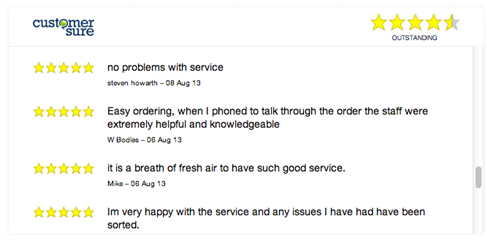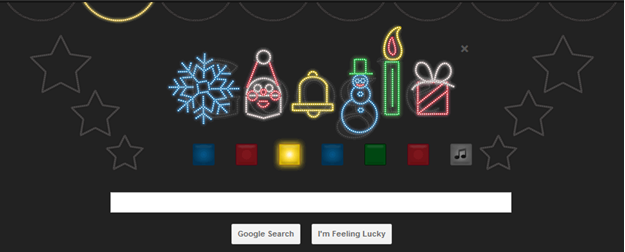
Christmas is almost here! Big brands are busy with promotional marketing activities, customer behavior spikes, and everyone wants to take advantage of this season to get noticed by their target market and make sales as well.
With all the buzz everywhere, you can step up your game and be on par with the big-timers! Here are 8 actionable tips to help you get started.
1. Research for Buyer Intent Keywords
First, make sure that your customers can find you. It’s easy to get buried and ignored with the multitude of websites trying to get noticed during the holiday season, and even big names have this problem from time to time. Make sure you know how to stand out from the crowd.

Image from ConsumerReports.org
Know who your buyers are and their buying intent(s)
Your potential buyers have a specific behavior when it comes to looking for what they wish to buy: they start looking through Google using very specific phrases such as “What to get your mom for Christmas”. These are called “long-tail keywords”, and are usually less competitive in terms of search engine results.
Gather a list of keywords and topics based on the holiday you are focusing on – for example, Christmas. You can do this by using Google Keyword Planner, or Conductor Searchlight’s Audience Intent Explorer. They will give you keywords based on what you search, as well as their frequency of usage.
2. Increase activity and convenience by optimizing your website

Even the way your website works can make or break a sale for you and your potential buyers. If they can do everything they want quickly and easily, plus get a few perks that they’d appreciate, they’d come back to your website more and would probably even turn to loyal customers.
Tip 1: Display a large search box prominently on your website

Image from ColorLib.com
The presence of a large search box in the center of your website can “entice up to 40% of users to search”, according to the CEO of Swiftype, Matt Riley. He also adds that “users who search convert at a 50% higher rate”. A large search box encourages your potential buyers to search what else they need that might be available in your website, since it’ll be easier for them to browse without having to go through your website’s catalogue repeatedly.
Tip 2: Add reviews to your product pages
Image from CustomerSure.com
Reviews are helpful for users who are looking for third-party opinions on items they are looking to buy. Some website providers, like WordPress, have plugins like WP Customer Reviews that equip your website with a review area where customers can leave theirs in. For those without plugins from their providers, you can use Testimonial Robot or InnovaReviews to add a review area to your website.
3. Create buzz on your products by the power of social media

It’s likely that anyone with access to an Internet connection has a social media account, where they spend time connecting with friends and family, as well as the rest of the world. This is also a great avenue to connect with your potential buyers as it provides a more interpersonal connection with them.
Tip 1: Promote your products, offers, blog posts, etc.

Image from SocialMediaToday.com
This is a no-brainer: you can use social media to announce your new articles, new offers, new items, etc. It’s the fastest way your customers will be informed of what’s happening with your website, and the fastest way news can travel through.
For an added exposure, consider using Facebook Ads, as they can appear in the News Feeds of people who might be interested in your posts based on their Interests or frequent searches. Your Facebook ads can also carry over to Instagram this way. Twitter, Pinterest, and Google also have advertising options which you can try out.
Tip 2: Hold social media contests

Image from RIgnite.com
Challenge your audience into participating by offering them something they can’t resist: a bundle of perks, items, or even free shipping. These contests can be anything from a “sharing” contest where a certain number of random people who shared your post will win, to contests where they must submit content like drawings, writing, or their opinion on one of your products.
Tip 3: Post things that are relevant to your products and to the holiday

Image from @cocacola (Instagram)
Judd Marcello, the vice president of marketing for Smartling, advices to “use social channels to get followers and fans to spread holiday cheer via promotions, deals, add-on sales and fun seasonal messages”. Whether your posts (particularly pictures) deal with your products directly or not, implying that you are with your customers in celebrating the holiday spirit appeals to them, and makes them engage more with your social media account and your website.
4. Make sure you post valuable contents for your holiday customers

Content marketing is still an infallible part of any good strategy. It gives information in an entertaining manner, but also motivates and convinces your customers to act depending on the type of what they read. Most companies use holiday-themed content, but posts that resemble sales pitches become the norm when the “shopping season” sets in. Everyone wants to sell, but this just drives customers away.
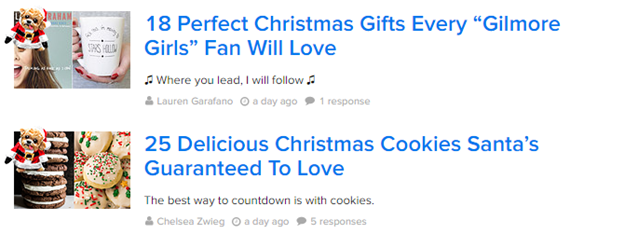
Image from christmas on Buzzfeed
Focus on getting people to know and recognize your brand, and relating your company to events and topics that matter to your audience. Don’t force a connection to the point that it tries too hard or makes no sense – your customers will pick it up. Strike the balance between making your brand known and relating to your audience.
Some of the topics you can go for are gift guides, 12 or 25 of something, holiday tips, or reminiscing posts (creating nostalgia).
5. Get in the holiday spirit with your website\’s theme

Your website’s appearance (as well as any other medium you use online) create interest and reinforce the holiday theme when you change its appearance accordingly. Some, however, think that there needs to be a complete overhaul of their theme and image when the holiday season rolls in. That doesn’t need to be the case – your branding can still shine through despite the change in atmosphere.
Tip 1: Consider adding festive elements to your existing design

Image from TheDeepEndDesign.com
Sometimes it’s enough that you change the colors a bit to reflect the holiday’s traditional scheme. For example, your black-and-white minimalist website could do with a splash of red and green, or changing your header image to something that incorporates the traditional symbols for the holidays. If you feel like adding virtual lights or tinsel won’t make your website look cluttered, add it in as well.
If you feel apprehensive about adding decorations in your website or doing festive cover photos and profile images for your social media pages, ask the help of a graphic designer you know, or hire one for your company. They can provide expert aesthetic opinion on designing and your websites and collaterals that your customers will appreciate as well.
Tip 2: Look through your website provider’s themes gallery for an upgrade
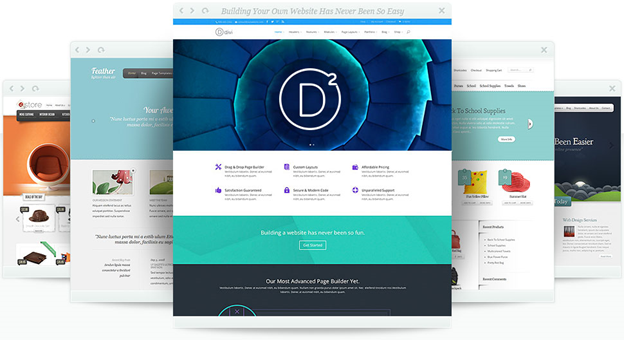
Image from ElegantThemes.com
Some website providers like Wix and WordPress have galleries where pre-existing themes can be used or bought for your website. It could be a nice gift to your users to present a better-looking website layout with festive elements for the season. Try to retain some similar elements from your old theme with the new one, so the change would not completely confuse your users.
Tip 3: Don’t overhaul your entire identity – just add and modify
Image from UnlockWindows.com
We’ve mentioned it before; you don’t need to design a completely new logo or change your default color scheme just to make the holiday design fit. Google lets its logo look more festive by adding elements like gifts or making an “o” look like a peppermint candy, but the logo is still the same, recognizable brand.
You’ll save a lot of stress by just seamlessly adding to your logo and not starting from the ground up when it isn’t needed.
6. Bring back abandoned cart shoppers by reminding and offering deals
Cart abandonment is when your customers try shopping in your website, put some items in their carts, then suddenly disappear or stop before they checkout the items. Business Insider says that the number one reason why people do this is because of unexpected changes in pricing, which usually occurs through the addition of shipping costs.
There is also the case of people just wanting to check out prices of items (which is why you should display prices outright beside the products), not being ready to purchase the items they were planning to, or not meeting the required value to avail of free shipping.
Tip 1: Remind them of their carts thoroughly and quickly
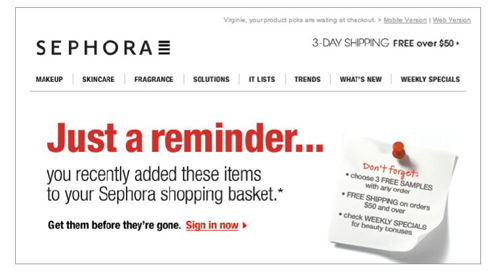
Image from WebsiteMagazine.com
In the case of not being ready to purchase the items, you can negate this by sending a personalized email to the abandoned cart shoppers to remind them that they still have remaining items in their cart, preferably 24 hours after they have abandoned it. That way, when they are ready to make a purchase, they remember their pending items.
The email must include the items they were about to purchase and all related information about it, such as price drops, quantities they were looking to purchase, and other related items in their wish list. Informing about discount codes or other available offers, as well as scarcity notices, are also necessary information that can convince them to buy their pending items sooner.
Step 2: Convince them to purchase NOW
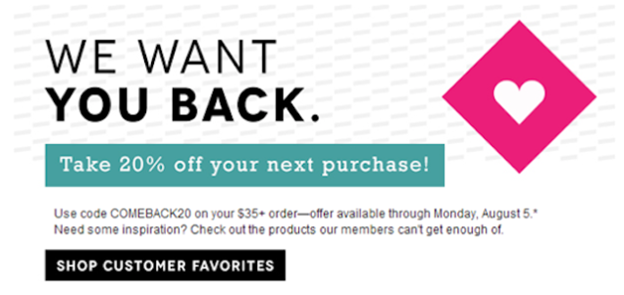
Image from Shopify.com
You can also offer deals like a few days of reserving the items they were looking to purchase, especially if you pair this with the sense of urgency that there are limited stocks left. You can also give them discount codes that will expire in a set number of days (akin to an activation code that will only last for a few days before you are asked to register again) to trigger them into purchasing.
7. Drive in more purchases by offering incentives

Nothing brings in more customers than incentives to buy and get what they want at a lower price. It’s part of the concept of reciprocity – when they buy something for you, you give something back to them in return.
Tip 1: Offer themed deals

Image from ShensAddiction.com
Chances are, your customers are looking for items from a set “category” to give out to people in their circles, for example, mothers that they know (e.g. a friend who is a mother, an aunt, a neighbor) or fans of a certain show or movie franchise. By offering them themed deals, like giving them an item from the category list for free when they meet a certain amount of purchases from that category, they are encouraged to buy more to qualify for that offer.
Tip 2: Free/discounted shipping

Image from CreativeIntent.com
In the above tip about cart abandonment, we mentioned that one of the major reasons why people don’t continue with purchases is because of shipping costs. Offering free or discounted shipping not only is a good way to minimize cart abandonment, but also entice buyers to purchase more to meet the required value for free shipping.
Also, consider offering discounted shipping if their purchases fall near the requirement for free shipping. This way, those who are disappointed about not meeting the free shipping can still get some compensation for their numerous purchases, and your customers will appreciate the discount.
Step 3: Coupons for first-time and top customers
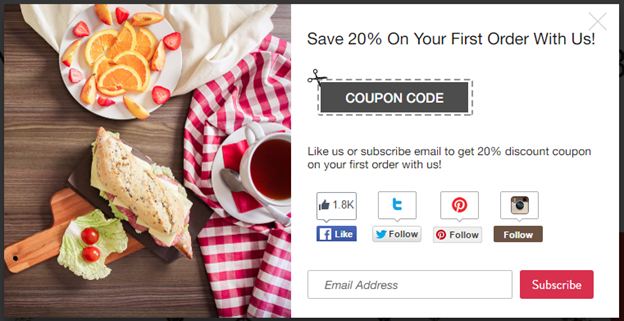
Image from Beeketing.com
First-time customers need a little more convincing to purchase from you, while top customers can use the appreciation. Coupons are a great way to introduce your first-time customers to what you can offer and to thank them for choosing you, while top customers will more than likely recommend you more to their peers due to the great treatment they are receiving.
8. Gain year-long loyal customers by running back full circle post-holidays

After the holidays are over, it might be tempting to go back to your natural swing of things, but that’s leaving your whole strategy high and dry. It’s best to end it with a good note, and to actually wrap up your holiday promotions and marketing strategy. Marloes Oost of Mapp advises to keep in mind that your audience is probably thinking ahead to the coming year, and to “give them what they need to start their year off on the right foot”. In short, show them support and that you are still there for them.

Image from Pinterest.com
If these tips seem complicated, always remember that you don’t need to do every single one of them – just pick what you think is the most effective for you.
Like Adam Baker would say, “Start small. Start with one.”
If you tried out one of our tips, share your experiences in the comments!

